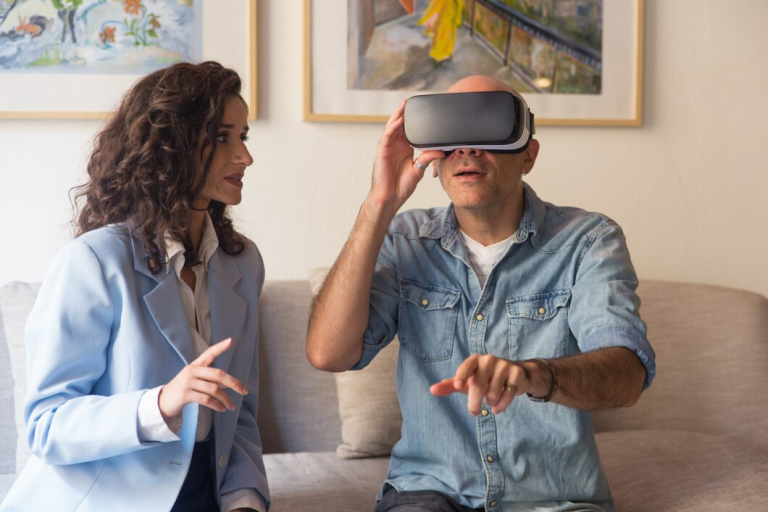How VR is Transforming Architectural Workflows
Virtual Reality (VR) is no longer just a futuristic concept—it’s revolutionizing architecture by enhancing design visualization, collaboration, and efficiency. Whether you’re designing residential homes, commercial buildings, or urban developments, integrating VR into your architectural workflow allows you to:
- Provide immersive client presentations
- Identify design flaws early in the process
- Improve team collaboration across different locations
- Reduce project costs by minimizing revisions
According to a 2024 report by McKinsey, firms adopting VR in their workflows see a 30-50% increase in efficiency and client satisfaction. However, successfully implementing VR requires the right tools, strategies, and best practices.
Let’s explore how architects can seamlessly integrate VR into their workflows.
1. Choosing the Right VR Software and Hardware
Why It’s Important:
Not all VR tools are created equal. Selecting the right combination of software and hardware ensures smooth integration into your design process.
Recommended VR Software for Architects:
- Enscape – Real-time rendering and VR visualization for Revit, SketchUp, and Rhino
- Unreal Engine & Twinmotion – High-fidelity, photorealistic architectural visualization
- Autodesk Revit VR – BIM-compatible VR for detailed building modeling
- Fuzor – Combines BIM with VR for immersive construction simulations
VR Hardware for Architecture Firms:
- Meta Quest 3 – Wireless, cost-effective, and perfect for client walkthroughs
- HTC Vive Pro 2 – High-resolution and excellent for detailed visualization
- Varjo XR-3 – Enterprise-grade VR for advanced architectural rendering
Best Practice: Invest in hardware that aligns with your project complexity and software that integrates seamlessly with your existing design tools.
2. Using VR for Concept Development and Design Validation
Why It’s Important:
VR allows architects to experience their designs at a human scale, leading to better spatial understanding and error detection before construction begins.
How to Use VR in Early Design Stages:
- Conduct virtual design reviews with clients and stakeholders
- Identify potential design issues before committing to costly changes
- Use VR simulations to test lighting, materials, and spatial flow
Best Practice: Start integrating VR early in the design phase to iterate quickly and reduce design errors.
3. Enhancing Client Presentations with Immersive Walkthroughs
Why It’s Important:
Traditional 2D renderings and blueprints often fail to convey the full vision of a project. With VR walkthroughs, clients can experience spaces as if they were already built, leading to faster approvals and fewer revisions.
How VR Enhances Client Engagement:
- Enables interactive tours where clients can explore spaces freely
- Provides real-time customization (e.g., changing materials, lighting, furniture)
- Helps non-technical clients understand spatial relationships more intuitively
Best Practice: Offer VR presentations as a premium service, giving clients a more immersive and engaging experience.
4. Streamlining Collaboration Between Teams and Stakeholders
Why It’s Important:
With remote work and global collaboration becoming more common, VR facilitates seamless communication between architects, engineers, contractors, and clients.
How VR Improves Collaboration:
- Allows real-time feedback on design modifications
- Enables remote team members to experience projects without being on-site
- Reduces miscommunication by providing a common visual reference
Best Practice: Use cloud-based VR platforms to share projects with teams across different locations.
5. Training and Upskilling Architects with VR
Why It’s Important:
As VR becomes more mainstream in architecture, firms must ensure their teams have the necessary skills to utilize it effectively.
Best Practices for Training Teams on VR:
- Provide hands-on training sessions for new software
- Encourage architects to explore VR modeling techniques
- Assign VR-based design exercises for interns and junior designers
Harvard Business Review reports that employees trained with VR learn up to 4x faster than traditional methods, making it an essential investment for architecture firms.
6. Overcoming Common Challenges in VR Integration
Potential Hurdles and Solutions:
- High upfront costs? Start with affordable VR headsets before scaling.
- Steep learning curve? Use intuitive, user-friendly VR software.
- Clients unfamiliar with VR? Offer guided VR walkthroughs and tutorials.
Final Thoughts: The Future of VR in Architecture
Integrating VR into your architectural workflow is no longer optional—it’s becoming a competitive advantage. By adopting the right tools, training teams, and refining processes, architects can:
- Improve design accuracy and reduce costly revisions
- Enhance client engagement and satisfaction
- Collaborate more effectively with remote teams
- Future-proof their practice against industry shifts
Ready to integrate VR into your architecture firm? Explore VR solutions with VRchitects today!






